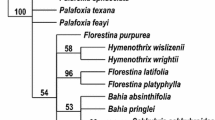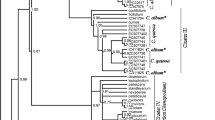Abstract
In this study, internal transcribed spacer (ITS) regions within the nuclear ribosomal DNA of KoreanIlex were analyzed in order to investigate any molecular evidence thatI. × wandoensis could serve as a putative hybrid betweenI. cornuta andI. integra. We also sought to clearly identify taxonomic relationships and problems caused by consecutive external morphological characters among taxa in the genus. We sequenced 20 clones fromI. × wandoensis and found these individuals displayed intra-genomic polymorphisms within ITS regions. The analysis of the clones clearly demonstrated the presence of discrete sequences from bothI. cornuta andI. integra, thereby confirmingI. × wandoensis is a species that was formed by crossingI. cornuta andI. integra. Lastly, the subgenusIlex, which contains the evergreen species, failed to form a monophyletic group in a strict consensus tree that was prepared based upon ITS regions.I. crenata var.microphylla in the subgenus KoreaIlex, which has presented taxonomic problems previously, formed an independent clade within the consensus tree, thereby showing distinction fromI. crenata.) Genetic discontinuity ofI. macropoda andI. Macropoda for.pseudo-macropoda individuals couldn't be confirmed.
Similar content being viewed by others
References
Alvarez I andWendel JF (2003) Ribosomal ITS sequences and plant phylogenetic inference. Mol. Phylogen. Evol. 29: 417–434.
Arnold ML (1997)Natural hybridization and evolution. Oxford University Press, Oxford.
Baldwin BG (1992) Phylogenetic utility of the internal transcribed spacers of nuclear ribosomal DNA in plants: An example from the Compositae. Mol. Phylogen. Evol. 1: 3–16.
Barton N (2001) The role of hybridization in evolution. Mol. Ecol. 10: 551–568.
Campbell CS.Wojciechowski MF, Baldwin BG, Alice LA andDonoghue MJ (1997) Persistent nuclear ribosomal DNA sequence polymorphism in theAmelanchier agamic complex (Rosaceae). Mol. Biol. Evol. 14: 81–90.
Chung TU, Do BS. Lee DB and Lee FJ (1937) Nomina Plantarum Koreanum. Chosen Nat. Hist. Soc. Seoul. 108 pp.
Cuenoud P, Martinez MDP, Loizeau PA, Spichiger R, Andrews S andManen JF (2000) Molecular phylogeny and Biogeography of the genus Dex L (Aquifoliaceae). Ann. Bot. 85: 111–122.
Doyle JJ andDoyle JA (1987) A rapid DNA isolation procedure of small quantities of fresh leaf tissue. Phytochem. Bull. Bot. Soc. Amer. 19: 11–15.
Dudley TR andYinger BR (1987a) 1985 U.S. National Arboretum Plant Exploration in the Republic of Korea, Southwest Coast and Islands Final Report: Part II. Holly Soc. J. 5: 10–16.
Dudley TR andYinger BR (1987b) 1985 U.S. National Arboretum Plant Exploration in the Republic of Korea, Southwest Coast and Islands Final Report: Part III. Holly Soc. J. 5: 4–13.
Dudley TR andYinger BR (1988) 1985 U.S. National Arboretum Plant Exploration in the Republic of Korea, Southwest Coast and Islands Final Report: Part IV. Holly Soc. J. 6: 5–13.
Engler A (1964)Syllabus der Pflanzenfamilien, 12 Auflage, pp. 289–292.
Farris JS (1989) The retention index and homoplasy excess. Syst. Zool. 38: 406–407.
Felsenstein J (1985) Confidence limits on phylogenies: an approach using the bootstrap. Evolution. 39: 783–791.
Galle FC (1997)Hollies. The Genus Ilex. Timber Press, USA.
Gottlieb AM, Giberti GC andPogglo L (2005) Molecular analysis of the genusIlex (Aquifoliaceae) in southern South America. Evidence from AFLP and ITS sequence data. Am. J. Bot. 92: 352–369.
Hume HH (1953)Hollies. The Macmillan Company, New York, pp. 80–102.
Hwang SH, Park SJ andKim JH (2007) A Numerical Taxonomy of KoreanIlex (Aquifoliaceae). Korean J. PI. Taxon. 37: 419–430.
Jackson RB, Moore LA, Hoffmann WA, Pockman WT andLinder CR (1999) Ecosystem rooting depth determined with caves and DNA. Proc. Natl. Acad. Sci. USA 96: 11387–11392. Genbank accession AF174625.
Jung YH, Han SH, Oh YS, Ko MH, Koh SC.Kim MH andOh MY (2000) Genetics variation and phylogenetic analysis of genusAbies distributed in Korea based on RAPD and nuclear rDNA ITS2 sequences. Korean J. Genetics 22: 341–354.
Kaplan Z andFehrer J (2007) Molecular evidence for a natural primary triple hybrid on plants revealed from direct sequencing. Ann. Bot. 99: 1213–1222.
Kim KH.Koh DS, Han CS.Seo BS andOh Kl (1985) Studies on the morphology of endemic Aquifoliaceae in Korea- II. pollen morphology by LM and SEM. Journal of Natural Science, Chonbuk National University 27: 255–259.
Kim KJ andJansen RK (1994) Comparisons of phylogenetic hypotheses among the different data sets in dwarf dadelion (Krigia, Astraceae): Additional information from internal transcribed spacer sequences of nuclear ribosomal DNA. PL Syst. Evol. 190: 157–185.
Kim YD, Park JW.Sun BY, Kim KJ.Lee EJ andKim SH (2005) ITS sequence variations in common ragweed and giant ragweed. Korean J. PI. Taxon. 35: 273–285.
Kimura M (1980) A simple method for estimating evolutionary rates of base substitution through comparative studies of nucleotide sequences. J. Mol. Evol. 16: 111–120.
Kluge AG andFarris JS (1969) Quantitative phyletics and the evolution of anurans. Syst Zool. 18: 1–32.
Koch M.Dobes C andMitchefl-Old T (2003) Multiple hybrid formation in natural populations: Concerted evolution of the internal transcribed spacer of nuclear ribosomal DNA(ITS) in North AmericanArabis divahcarpa (Brassicaceae). Mol. Biol. Evol. 20: 338–350.
Koh MH, Kim YS andOh HK (2005) Morphological characteristics of Chinese Holly (Ilex cornuta) leaves in Korea. Kor. Journ. Env. Eco. 19: 347–357.
Lee CS, Lee NS and Yeau SH (2004) Molecular phylogenetic relationship and speciation ofRanunculus cantoniessis (Ranunculaceae). Korean J. PI. Taxon. 34: 335–359.
Lee JS (1983) Studies on the natural distribution and ecology ofIlex cornuta Lindley et Pax. Jour. Korean For. Soc. 62: 24–42.
Lee NS, Y SH, Park JO andRoh MS (2006) Molecular evidence for hybridization ofIlex x wnadoensis (Aquifoliaceae) by RAPD analysis. J. Plant Biol. 49: 491–497.
Lee WT (1996)Lineamenta Florae Koreae Academybook, Seoul, pp. 670–672.
Lookerman DJ andJansen RK (1996) The use of herbarium material for DNA studies. InSampling the green world. Stussey T. J. and S. Sohmer, eds., Columbia University Press, New York, pp. 205–220.
Miller CF andKim M (2002)Ilex x wandoensis C.F Miller & M. Kim, a new hybrid species ofIlex Aquifoliaceae) from Korea. Korean J. PI. Taxon. 32: 293–299.
Mori T (1921)An enumeration of plant hitherto known from Corea. Gov. Chos., pp. 161–163.
Nakai T (1909) Flora Koreana I. Coll. Sci. Imp. Univ., Tokyo, 26: 119.
Nakai T (1952) A Synoptical Sketch of Korean Flora. Bull. Nat Sci. Mus. Tokyo 31: 148.
Pali bin J (1898)Conspectus Florae Koreae. 52 pp.
Park CM, Seo BS, Kim KH, Park JM andLim SJ (2000) Inhabitation environments and growth conditions ofIlex cornuta community in Pyonsanbando. Kor. Insti. Traditional Landscape Arch. 18; 100–115.
Rieseberg LH (1997) Hybrid origin of plant species. Annu. Rev. Ecol. Evol. Sc. 28: 359–389.
Rieseberg LH.Raymond O, Rosenthal DM, Lai Z, Livingstone K, Nakazato T, Durphy JL, Schwarzbach AE, Donovan LA andLexer C (2003) Major ecological transition in wild sunflowers facilitated by hybridization. Science 301: 1211–1216.
Son SW.Kim JH, Kim YS andPark SJ (2007) ITS sequence variation in populations ofIlex cornuta (Aquifoliaceae). Korean J. PI. Taxon. 37: 131–141.
Swofford DL (2002) PAUP: Phylogenetics analysis using parsimony and other methodCver. 4.0), Sinauer Associates, Sunderland, MA.
Thompson JD, Gibson TJ, Plewniak F.Jeanmougin F andHiggins DG (1997) The Clustal X window interface: Flexible strategies for multiple sequence alignment aided by quality tool. Nuc. Acids. Res. 25: 4876–4882.
White TJ, Bims T, Lee S andTaylor J (1990) Amplification and direct sequencing of fungal ribosomal RNA genes for phylogenetics. InPCR protocol: A guide to methods and applications, Innis M., D. Glefand, J. Sninsky and T. White, eds, Academic Press, San Diego, pp. 315–322.
Yim KB (1979) Variation of genusIlex in Korea and ornamental values. Jour. Kor. For. Soc. 42: 1–38.
Yoo KO. Jang SK and Lee WT (2005) Phylogeny of KoreanViola based on ITS sequences. Korean J. Pl. Taxon. 35: 7–23.
Author information
Authors and Affiliations
Corresponding authors
Rights and permissions
About this article
Cite this article
Son, SW., Kim, JH., Kim, KJ. et al. Molecular evidence for the hybridity ofIlex × wandoensis and the phylogenetic study of KoreanIlex based on ITS sequence data. Genes & Genomics 31, 53–63 (2009). https://doi.org/10.1007/BF03191138
Received:
Accepted:
Issue Date:
DOI: https://doi.org/10.1007/BF03191138




